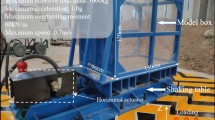Abstract
Pushover analysis is common because of its conceptual simplicity and computational attractiveness in computing seismic demand. Considering that traditional pushover analysis is restricted in underground structures due to the stark differences in the seismic response characteristics of surface structures, this paper proposes a pushover analysis method for underground structures and its application in seismic damage assessment. First, three types of force distribution are presented based on ground response analysis. Next, the target displacements and analysis models are established according to force-based and performance-based design. Then, the pushover analysis procedure for underground structures is described. Next, the applicability of pushover analysis to underground structures is verified by comparing the responses of a Chongwenmen subway station determined by the proposed procedure and by nonlinear response history analysis. In addition, two other points are made: that the inverted triangular distribution of effective earthquake acceleration is more practical than the other two distributions, and that performance-based design is more effective than force-based design. Finally, a cyclic reversal loading pattern based on one cycle of reversal loads as an earthquake event is presented and applied to the seismic damage assessment of underground structures. The results show that the proposed pushover analysis can be effectively applied to the seismic design and damage assessment of underground structures.
Similar content being viewed by others
References
Goel R K, Singh B, Zhao J. Underground Infrastructures: Planning, Design, and Construction. Butterworth Heinemann: Burlington, 2012. 1–9
Uenishi K, Sakurai S. Characteristic of the vertical seismic waves associated with the 1995 Hyogo-ken Nanbu (Kobe), Japan earthquake estimated from the failure of the Daikai Underground Station. Earthquake Eng Struct Dyn, 2000, 29(6): 813–821
Wang W L, Wang T T, Su J J, et al. Assessment of damage in mountain tunnels due to the Taiwan Chi-Chi Earthquake. Tunnelling and Underground Space Technology, 2001, 16(3): 133–150
Chian S C, Tokimatsu K. Floatation of underground structures during the Mw9.0 Tohoku earthquake of 11th March 2011. Proceedings of the 15th world conference on earthquake engineering. Lisbon; 2012
Hashash Y, Hook J J, Schmidt B. Seismic design and analysis of underground structures. Tunnelling and Underground Space Technology, 2001, 16(4): 247–293
Liu J B, Li B. A unified viscous-spring artificial boundary for 3-D static and dynamic applications. Sci China Ser E-Tech Sci, 2005, 48: 570–584
Lu Y D, Liu J B. A direct method for analysis of dynamic soil-structure interaction. China Civil Eng J, 1998, (3): 008
ATC-40. Seismic evaluation and retrofit of concrete buildings. California Seismic Safety Commission, 1996
FEMA-273. NEHRP guidelines for the seismic rehabilitation of buildings. Washington, DC, 1997
Chopra A K, Goel R K. A modal pushover analysis procedure for estimating seismic demands for buildings. Earthquake EngStruct Dyn, 2002, 31(3): 561–582
Reyes J C, Chopra A K. Three-dimensional modal pushover analysis of buildings subjected to two components of ground motion, including its evaluation for tall buildings. Earthquake Eng Struct Dyn, 2011, 40(7): 789–806
Camara A, Astiz M A. Pushover analysis for the seismic response prediction of cable-stayed bridges under multi-directional excitation. Eng Struct, 2012, 41: 444–455
Nishioka T, Unjoh S. A simplified evaluation method for the seismic performance of underground common utility boxes. Proceedings 2003 Pacific Conference on Earthquake Engineering. 2003
Liu J B, Li B, Liu X Q. A static elasto-plastic analysis method in seismic design of underground structures. China Civil Eng J, 2007, 40(7): 68–76
Li B. Theoretical Analysis of Seismic Response of Underground Subway Structures and its Application. Dissertation of Doctoral Degree. Beijing: Tsinghua University, 2005
Idriss I M, Sun J I. SHAKE91: A Computer Program for Conducting Equivalent Linear Seismic Response Analysis of Horizontally Layered Soil Deposits User’s Guide. California: University of California, Davis, 1992
Bardet J P, Ichii K, Lin C H. EERA: A Computer Program for Equivalent-linear Earthquake Site Response Analysis of Layered Soil Deposits User’s Manual. Los Angeles: University of Southern California, 2000
The people’s Republic of China Code. Code for Seismic Design of Buildings (GB 50267-97). Beijing: China Architecture and Building Press, 2010
Liu J B, Li B. Issues on the seismic analysis and design of subway structures. China Civil Eng J, 2006, 39(6): 106–110
Ghobarah A. Performance-based design in earthquake engineering: State of development. Eng Struct, 2001, 23(8): 878–884
Hajirasouliha I, Asadi P, Pilakoutas K. An efficient performance-based seismic design method for reinforced concrete frames. Earthquake Eng Struct Dyn, 2012, 41(4): 663–679
Gupta A, Krawinkler H. Estimation of seismic drift demands for frame structures. Earthquake Eng Struct Dyn, 2000, 29(9): 1287–1305
SEAOC. Vision 2000, Performance based seismic engineering of buildings, vols. I and II: Conceptual framework. Sacramento (CA): Structural Engineers Association of California, 1995
Miao Z W, Ye L P, Guan H, et al. Evaluation of modal and traditional pushover analyses in frame-shear-wall structures. Adv Struct Eng, 2011, 14(5): 815–836
Marc MSC, Version MSCMUM. MSC. Software Corporation, Santa Ana, CA, 2004
Pakbaz M C, Yareevand A. 2-D analysis of circular tunnel against earthquake loading. Tunnelling and Underground SpaceTechnology, 2005, 20(5): 411–417
Ghobarah A, Abou Elfath H, Biddah A. Response-based damage assessment of structures. Earthquake Eng Struct Dyn, 1999, 28(1): 79–104
Author information
Authors and Affiliations
Corresponding author
Rights and permissions
About this article
Cite this article
Liu, J., Wang, W. & Dasgupta, G. Pushover analysis of underground structures: Method and application. Sci. China Technol. Sci. 57, 423–437 (2014). https://doi.org/10.1007/s11431-013-5430-z
Received:
Accepted:
Published:
Issue Date:
DOI: https://doi.org/10.1007/s11431-013-5430-z




